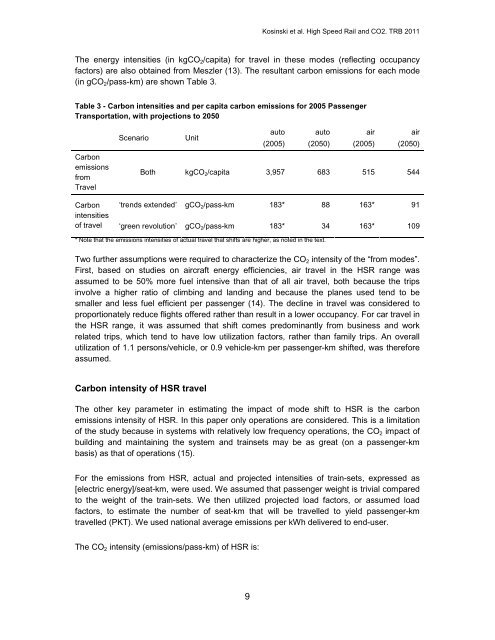Analysis of High-Speed Rail's Potential to Reduce CO2 Emissions ...
Analysis of High-Speed Rail's Potential to Reduce CO2 Emissions ...
Analysis of High-Speed Rail's Potential to Reduce CO2 Emissions ...
You also want an ePaper? Increase the reach of your titles
YUMPU automatically turns print PDFs into web optimized ePapers that Google loves.
9<br />
Kosinski et al. <strong>High</strong> <strong>Speed</strong> Rail and <strong>CO2</strong>. TRB 2011<br />
The energy intensities (in kg<strong>CO2</strong>/capita) for travel in these modes (reflecting occupancy<br />
fac<strong>to</strong>rs) are also obtained from Meszler (13). The resultant carbon emissions for each mode<br />
(in g<strong>CO2</strong>/pass-km) are shown Table 3.<br />
Table 3 - Carbon intensities and per capita carbon emissions for 2005 Passenger<br />
Transportation, with projections <strong>to</strong> 2050<br />
Carbon<br />
emissions<br />
from<br />
Travel<br />
Scenario Unit<br />
au<strong>to</strong><br />
(2005)<br />
au<strong>to</strong><br />
(2050)<br />
air<br />
(2005)<br />
air<br />
(2050)<br />
Both kg<strong>CO2</strong>/capita 3,957 683 515 544<br />
Carbon<br />
intensities<br />
‘trends extended’ g<strong>CO2</strong>/pass-km 183* 88 163* 91<br />
<strong>of</strong> travel ‘green revolution’ g<strong>CO2</strong>/pass-km 183* 34 163* 109<br />
* Note that the emissions intensities <strong>of</strong> actual travel that shifts are higher, as noted in the text.<br />
Two further assumptions were required <strong>to</strong> characterize the <strong>CO2</strong> intensity <strong>of</strong> the “from modes”.<br />
First, based on studies on aircraft energy efficiencies, air travel in the HSR range was<br />
assumed <strong>to</strong> be 50% more fuel intensive than that <strong>of</strong> all air travel, both because the trips<br />
involve a higher ratio <strong>of</strong> climbing and landing and because the planes used tend <strong>to</strong> be<br />
smaller and less fuel efficient per passenger (14). The decline in travel was considered <strong>to</strong><br />
proportionately reduce flights <strong>of</strong>fered rather than result in a lower occupancy. For car travel in<br />
the HSR range, it was assumed that shift comes predominantly from business and work<br />
related trips, which tend <strong>to</strong> have low utilization fac<strong>to</strong>rs, rather than family trips. An overall<br />
utilization <strong>of</strong> 1.1 persons/vehicle, or 0.9 vehicle-km per passenger-km shifted, was therefore<br />
assumed.<br />
Carbon intensity <strong>of</strong> HSR travel<br />
The other key parameter in estimating the impact <strong>of</strong> mode shift <strong>to</strong> HSR is the carbon<br />
emissions intensity <strong>of</strong> HSR. In this paper only operations are considered. This is a limitation<br />
<strong>of</strong> the study because in systems with relatively low frequency operations, the <strong>CO2</strong> impact <strong>of</strong><br />
building and maintaining the system and trainsets may be as great (on a passenger-km<br />
basis) as that <strong>of</strong> operations (15).<br />
For the emissions from HSR, actual and projected intensities <strong>of</strong> train-sets, expressed as<br />
[electric energy]/seat-km, were used. We assumed that passenger weight is trivial compared<br />
<strong>to</strong> the weight <strong>of</strong> the train-sets. We then utilized projected load fac<strong>to</strong>rs, or assumed load<br />
fac<strong>to</strong>rs, <strong>to</strong> estimate the number <strong>of</strong> seat-km that will be travelled <strong>to</strong> yield passenger-km<br />
travelled (PKT). We used national average emissions per kWh delivered <strong>to</strong> end-user.<br />
The <strong>CO2</strong> intensity (emissions/pass-km) <strong>of</strong> HSR is:

















